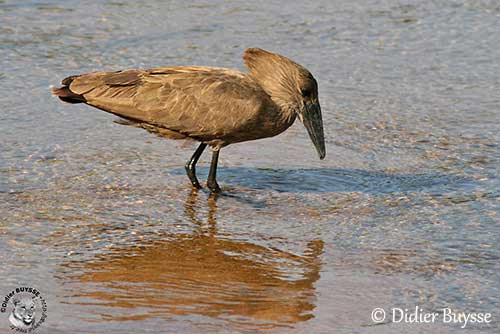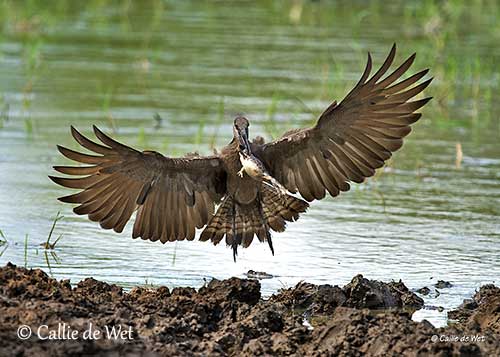Fr: Ombrette africaine
Ang: Hamerkop
All : Hammerkopf
Esp : Avemartillo
Ital : Uccello martello
Nd: Hamerkop
Sd: Skuggstork
Photographers:
Didier Buysse
Vision d’Oiseaux
Steve Garvie
RAINBIRDER Photo galleries & Flickr Rainbirder
William Price
PBase-tereksandpiper & Flickr William Price
Ingo Waschkies
Bird Photography
Callie de Wet
GALERIE
Text by Nicole Bouglouan
HANDBOOK OF THE BIRDS OF THE WORLD vol 1 by Josep del Hoyo-Andrew Elliot-Jordi Sargatal - Lynx Edicions - ISBN: 8487334105
L’ENCYCLOPEDIE MONDIALE DES OISEAUX - Dr Christopher M. Perrins - BORDAS - ISBN: 2040185607
BIRDS OF AFRICA SOUTH OF THE SAHARA by Ian Sinclair and Peter Ryan - Princeton University Press Princeton and Oxford - ISBN: 0691118159
HBW Alive
Wikipedia, the free encyclopaedia
CREAGUS@Monterey Bay (Don Roberson)
About Animals – Hamerkop - Bird of many Legends
Biodiversity Explorer – The Web of Life in Southern Africa
Hamerkop
Scopus umbretta
Pelecaniformes Order – Scopidae Family
INTRODUCTION:
The Hamerkop is the sole member of the family Scopidae and has two subspecies. This waterbird is unmistakable with all-brown plumage, large “hammer-shaped” head giving it the other name “hammerhead”.
This species frequents a wide variety of wetlands with trees for nesting. It feeds mainly on aquatic invertebrates and fish, shrimps, insects and rodents. It forages alone or in pairs during the day.
The Hamerkop is known for its huge stick nest placed in tree fork. Both parents share the nesting duties.
The Hamerkop is affected by deterioration in wetland water quality caused by pesticides. But currently, the population appears to be stable or increasing and the species is not globally threatened.
DESCRIPTION OF THE BIRD:
Biometrics:
Length: 47-56 cm
Wingspan: 90-94 cm
Weight: 415-430 g
The Hamerkop has brown plumage overall, with light and dark glossy, purplish streaks on wings and body. It has large wings and relatively short tail with dark terminal band. There is a square blunt crest on the nape.
The heavy, powerful black bill is slightly hooked at tip. The eyes are brown to pale brown. Legs and feet are blackish, with partially webbed toes.
Male and female are similar.
The juvenile resembles adults. The chicks have grey down and broad bills.
SUBSPECIES AND RANGE:
The Hamerkop lives in Africa, south of Sahara. Two subspecies share the large range.
S.u. minor is found in the coastal belt of W Africa from Sierra Leone to E Nigeria.
This race is smaller than nominate, with darker and duller plumage.
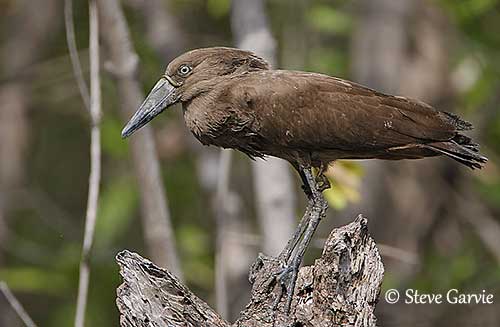
S.u. umbretta (described above) occurs in most of tropical Africa, SW Arabia and Madagascar.
HABITAT:
The Hamerkop is found in a variety of shallow wetlands. It frequents lake shores, marshes, and well vegetated rocky wades with slowly-running waters, ricefields, fish ponds, but it can be found in savannas and forests too. It is visible from 300 to 3,000 metres of elevation. The pairs need large trees for nesting and roosting.
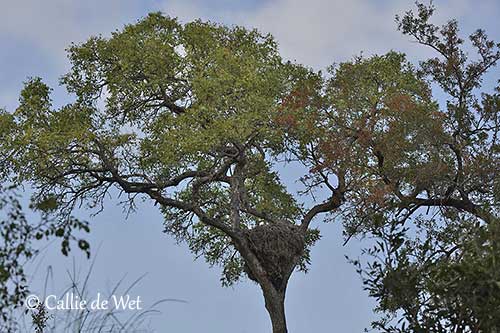
CALLS AND SONGS: SOUNDS BY XENO-CANTO
The Hamerkop is silent when alone. If several birds call at the same time, the noise is loud and distracting.
The song is a series of shrill piping whistles. During displays, it produces a series of nasal notes described as “yip-yip-yip-yip-yip-prrrrrrrrr” or similar.
We can also hear a far-carrying laughing call with rising inflexion, whereas in flight, it utters a high-pitched and nasal “yip” or “kek”.
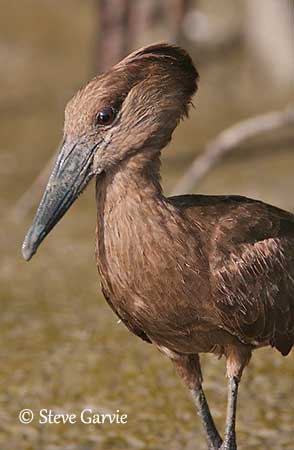
BEHAVIOUR IN THE WILD:
The Hamerkop feeds on frogs, tadpoles, fish, shrimps, aquatic invertebrates, insects and grasshoppers.
It often stands still, hunched, or actively feeding, running near water, making jabbing movements. It often perches on the back of hippopotamuses, searching for frogs.
The Hamerkop stalks its preys by wading in shallow water, and striking forward with the bill. Then, it deposes the prey on the ground prior to eat it. It also probes into the mud, searching for invertebrates. They are active at dusk, and rest during the day in large trees.
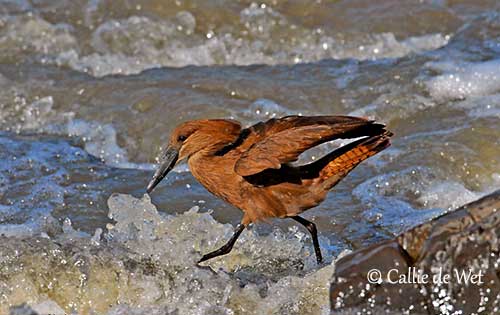

During the courtship displays, several birds can be seen dancing, hopping on each other’s backs, stretching their fluttered wings, raising their crest, and making a chorus of cries going on for a moment. Often, ten birds may call loudly, while running around each other. “False mounting” sometimes involves a male mounting a crouched female, pretending to copulate.
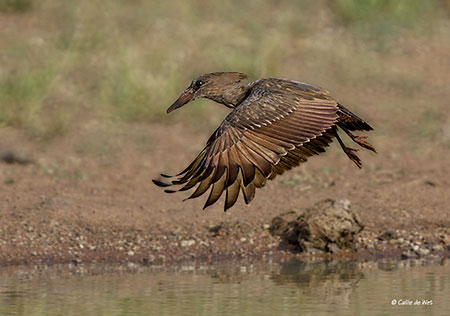
The Hamerkops usually live in pair or in small flocks. The bulky nest is often compared to an apartment, housing several generations of Hamerkops or other animals such as bees, mongooses, lizards and snakes. These domed nests are among the most extraordinary constructions by birds. A pair may build several nests within its territory, some of which are never used.
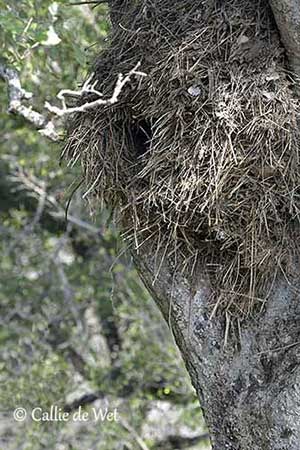
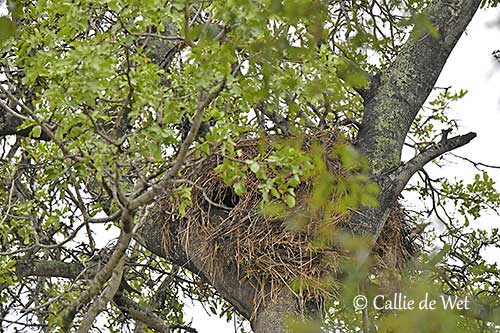
This species is sedentary. It remains in a well-defined territory. Some birds may move to dryer areas when the rainfalls are too abundant.
The Hamerkop flies with slow wing beats, often interspersed with glides on slightly bowed wings. But it doesn’t soar easily, with its short tail and large wings. When it is soaring, it stretches its head forwards. It is fond of soaring.
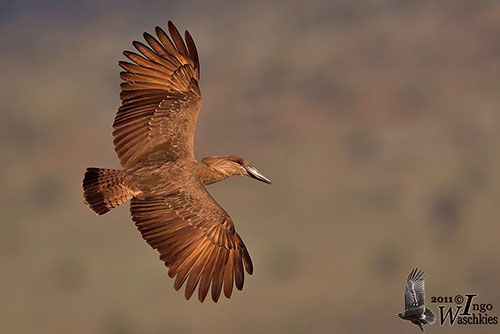
REPRODUCTION OF THIS SPECIES:
The nest of the Hamerkop is a very bulky structure. It may size 2 metres wide and height, and 25 to 50 kg weight. Six weeks or more are required to build this enormous nest made by both mates with twigs, sticks, reeds, grasses and stems of aquatic vegetation. The chamber is lined with clay and mud, but also with waterweeds and dry grasses. There is a burrow-shaped entrance hall on one side, which opening is reduced with mud. The nest is located in tree fork near water, or on cliff, or on the ground. The nest is usually decorated on the outside with bright-coloured objects and unusual materials.
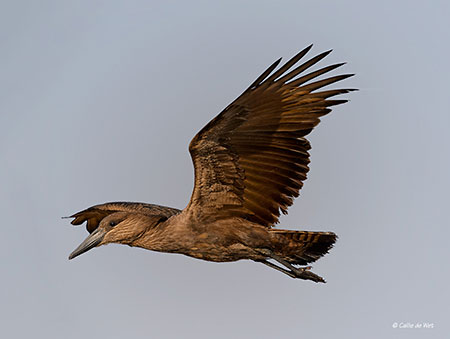
S.u. umbretta
The female lays 3 to 7 white eggs. The incubation lasts about 30 days, by both parents. At hatching, the chicks have grey down and broad, black bill.
The young are fed by both adults and are highly dependent. They fledge about 44-50 days after hatching, but they roost at night in the nest during one month or more.
PROTECTION / THREATS / STATUS:
The Hamerkop has supernatural powers for the indigenous people. They may go away, removing their huts, if a Hamerkop flies directly overhead. Some cultures consider it to be magical and others as an evil omen.
This species is not currently endangered. It is hold in a position of respect, and Hamerkops survive and flourish in the presence of men.
The population is stable or increasing with creation of artificial wetlands, but the birds may be affected by excessive use of pesticides.
The Hamerkop is not globally threatened and currently evaluated as least Concern.
